Why is the RAF celebrating 10 years of this plane?
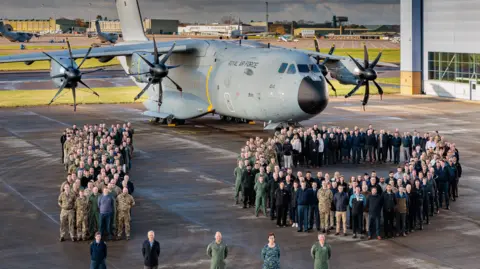 RAF Brize Norton
RAF Brize NortonResidents living near RAF Brize Norton are no stranger to large military aircraft flying overhead, be it the C17 Globemaster or the Voyager.
But one in particular has been taking centre stage at the Oxfordshire base - the Atlas A400M.
All 22 of the UK's fleet, for military transport and other operations, are based there.
The aircraft is being celebrated to mark its 10th anniversary but why is it such a special plane?
'Turboprop engines'
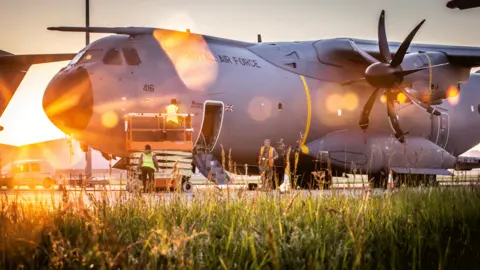 RAF
RAFAir Commodore Dan James, who is in charge of all of the aircraft at RAF Brize Norton, describes the A400M as a "really versatile" aircraft, able to "carry passengers, carry freight, and vehicles that can be driven on, then secured and locked into position".
He says the large plane with "turboprop engines" can carry up to 37 tonnes of freight, more than 2,000 miles.
"But what it's also brilliant at is tactical air transport - so it can land on strips, can do parachuting, it can deliver loads from the air," he explains.
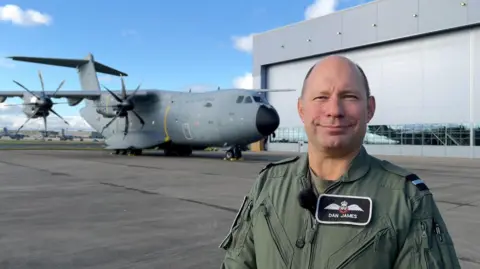
Compared to its predecessor the Hercules, "it can land and take off from a smaller runway or shorter runway, so it's got tremendously powerful brakes", he continues.
"The engines are also really powerful - this is what it was really designed for."
Air Cdre James says the A400M has been "busy supporting defence outputs".
This includes providing supplies for the war in Ukraine, carrying out maritime air reconnaissance in the Falklands, and even air drops in Antarctica.
"We used it on the D-Day 80 and the Arnhem landings to work up our low-level parachuting capability," he adds.
'Fly-by-wire' technology
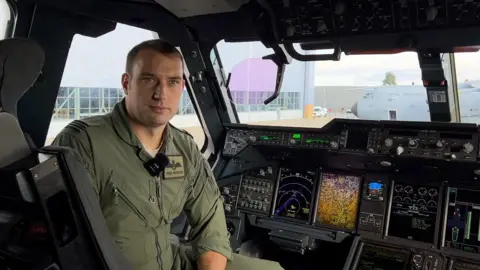
Flight Lieutenant Tariq Rodgers is an A400M captain on the front line, and flew people out of Kabul in Afghanistan after it was taken over by the Taliban.
"It was quite harrowing to be there, but rewarding," he recalls.
"Probably the most rewarding thing I've done, both on this aircraft and in my career with the air force as well.
"You see the amount of people and how little they have with them, it really feels like you’re making more of a difference.
"Rather than just moving freight around, which is equally as important, getting these people out - you're changing lives forever."
He says the plane itself has "real, up-to-date, state of the art technology" and is a "joy to fly".
Flt Lt Rodgers also explains how the A400M is "fly-by-wire" which means the pilot is not controlling anything mechanical - its all inputted into a computer.
"We tell the aircraft where to go in the sky and it'll do it based on what it thinks needs to happen," he explains.
A400M Atlas specifications
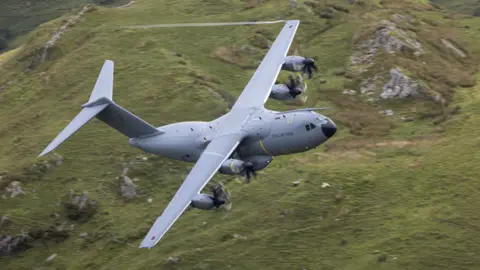 RAF
RAFLength: 147ft 11in (45.10m)
Height: 48ft 3in (14.70m)
Wingspan: 139ft 1in (42.40m)
Maximum speed: 400 knots (741km/h, 460mph)
Maximum altitude: 40,000ft (12,192m)
Maximum payload: 81,600lb (37,000kg)
Source: RAF
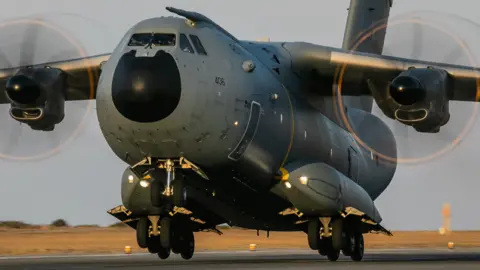 RAF
RAFThe A400M was delayed and over-budget by the time the first of the transport planes was officially launched.
There was also a fatal crash in 2015 during a test flight in Seville, Spain, which was later thought to be down to the accidental deleting of files in its software.
But Air Cdre James says the aircraft have ultimately "settled in well", despite "inevitable" issues "which is normal for a modern hi-tech aircraft".
He concludes: "We have successfully taken over from the Hercules which we retired early, and deliberately so."
Simon Haywood, head of Airbus A400M support centre team - involved in the design and manufacture of the aircraft - predicts it could stay in service for up to 30 years.
"We haven't tapped into its full capability yet, so it's a game changer in terms of its capability," he says.
